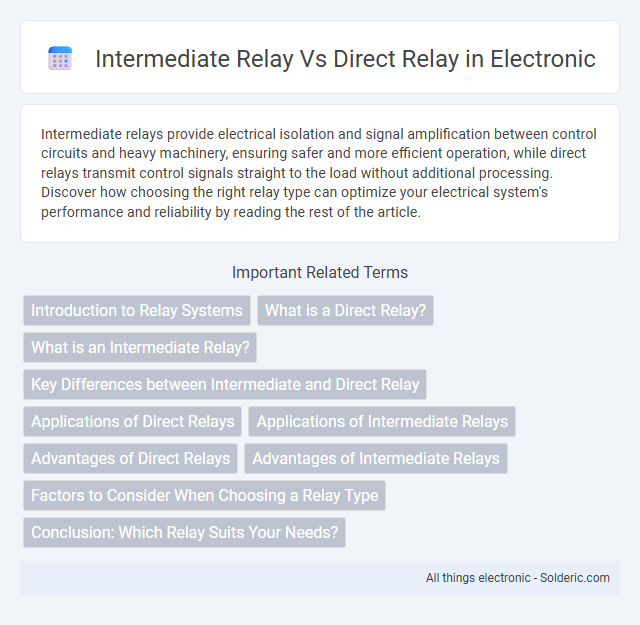Intermediate relays provide electrical isolation and signal amplification between control circuits and heavy machinery, ensuring safer and more efficient operation, while direct relays transmit control signals straight to the load without additional processing. Discover how choosing the right relay type can optimize your electrical system's performance and reliability by reading the rest of the article.
Comparison Table
| Feature | Intermediate Relay | Direct Relay |
|---|---|---|
| Connection Type | Relays data via an intermediate node | Directly connects sender and receiver |
| Latency | Higher latency due to extra hop | Lower latency with direct path |
| Reliability | Improved fault tolerance through redundancy | Dependent on direct link stability |
| Use Case | Network conditions prevent direct connection | Optimal when direct peer-to-peer is possible |
| Security | Additional node may introduce vulnerability | Fewer points of attack |
| Bandwidth | Potential bottleneck at intermediate relay | Generally higher throughput |
Introduction to Relay Systems
Relay systems function as critical communication intermediaries, enabling secure and efficient message transmission in decentralized networks. Intermediate Relay operates by routing data through multiple nodes, enhancing privacy and resilience against censorship or surveillance. Direct Relay connects sender and receiver via a single relay node, offering lower latency but less obfuscation compared to the multi-hop architecture of Intermediate Relay.
What is a Direct Relay?
A Direct Relay is a communication method in which data signals are transmitted directly from the source to the destination without passing through intermediate devices. This approach minimizes latency and reduces potential points of failure, enhancing signal integrity and overall system performance. Your network efficiency can improve with Direct Relay by streamlining the data path and avoiding unnecessary relay nodes.
What is an Intermediate Relay?
An Intermediate Relay is a specialized server in a network environment that processes and forwards authentication requests between clients and domain controllers, improving security and efficiency in authentication workflows. It acts as a mediator to relay Kerberos tickets without exposing user credentials directly to the domain controller. Your network benefits from reduced exposure to credential theft and enhanced control over authentication traffic by using Intermediate Relay rather than Direct Relay, where requests go straight to the domain controller.
Key Differences between Intermediate and Direct Relay
Intermediate relay involves an additional relay device that receives and retransmits signals, extending communication range and enhancing network stability, while direct relay connects the source and destination devices without intermediary nodes, providing lower latency. Intermediate relays improve coverage and reliability in complex or large-scale networks, making them ideal for expansive IoT deployments. Direct relays are more efficient for short-range, low-latency communication where network simplicity and speed are prioritized.
Applications of Direct Relays
Direct relays are primarily used in power systems for immediate fault detection and isolation, ensuring rapid protection of transformers, generators, and transmission lines. Their application is crucial in scenarios requiring minimal time delay to prevent equipment damage and maintain system stability. Industries such as utilities and manufacturing heavily rely on direct relay protection to secure critical electrical infrastructure.
Applications of Intermediate Relays
Intermediate relays are widely used in industrial automation and control systems to extend the number of inputs and outputs, enabling complex logic operations and signal amplification that direct relays cannot handle efficiently. They act as interface devices between low-level control circuits and high-power equipment, ensuring safe and reliable operation in applications like motor control, protection relays, and sequential control processes. Your control system benefits from intermediate relays by increasing flexibility and improving the longevity and safety of electrical components.
Advantages of Direct Relays
Direct relays offer enhanced reliability by reducing the number of components in the protection scheme, minimizing potential failure points. Their faster response times improve system safety by quickly isolating faults, which is critical for minimizing equipment damage and downtime. By simplifying the design, Direct Relays lower maintenance costs and improve operational efficiency, making them an advantageous choice for your protection system.
Advantages of Intermediate Relays
Intermediate relays offer enhanced safety and isolation by separating control circuits from high-power loads, reducing the risk of equipment damage and electrical hazards. You benefit from greater flexibility in complex control systems, as intermediate relays enable easy signal amplification, logic functions, and remote control integration. This approach also improves system reliability by minimizing direct exposure of sensitive devices to electrical faults and overloads.
Factors to Consider When Choosing a Relay Type
When choosing between intermediate relay and direct relay, you should consider factors such as the complexity of the control circuit, the required isolation level, and the speed of operation. Intermediate relays offer greater flexibility and can handle multiple control signals, which is ideal for complex automation systems, while direct relays provide faster response times with fewer components. Voltage rating, load capacity, and installation space are also critical to ensure compatibility with your specific electrical application.
Conclusion: Which Relay Suits Your Needs?
Intermediate Relay offers enhanced flexibility and improved security by insulating your network from direct exposure, making it ideal for environments requiring layered protection. Direct Relay provides lower latency and simpler configuration, suitable for scenarios prioritizing speed and straightforward deployment. Your choice depends on balancing security needs with performance expectations to match your specific operational requirements.
Intermediate Relay vs Direct Relay Infographic

 solderic.com
solderic.com